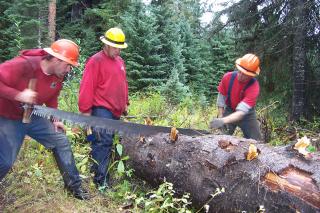Residents at Work

The Idaho Department of Correction strives to keep residents busy in education, treatment or work. Residents in institutional jobs and on work crews are not employees and do not enjoy any of the benefits provided to employees in public jobs. Many residents lack job skills. Learning to work with others, follow instructions and put forth earnest effort are valuable skills that many residents need to be successful after their release. With the money earned, residents can send money home, pay restitution, child support and purchase items from the commissary. If the IDOC has a court order, for child support, restitution, etc., a percentage of the resident’s earnings is deducted automatically.
Institutional Work Detail: Many residents' first job is on institutional labor detail. The institutional labor detail (ILD) is a crew of residents whose primary job is to maintain large areas such as prison grounds and parking areas. ILD workers are normally not paid for their work, but good performance on ILD is often required before a resident will be considered for an institutional work assignment.
Institutional Workers: With the exception of security, IDOC utilizes residents to work in most areas of the correctional facilities’ operations. For example one staff member will supervise the food service operation, but all of the workers are residents. Skilled employees fill maintenance positions, but supervise a crew of resident workers who do much of the maintenance on facilities, vehicles and grounds. The Division of Prisons employs no janitorial staff; all of that work is done by residents.
Vocational Work Projects: Unlike ILD and institutional workers, vocational work crews leave the facility to work. Vocational work crews are comprised of minimum and community custody residents. ICIO, SICI, PWCC and SAWC operate vocational work projects. Vocational work projects are crews supervised by security staff. Vocational work projects such as forest fire and conservation crews provide much needed labor to state, city, county and federal government agencies. Working on a vocational work crew is an achievement for the resident. Not only is it the best paying job other than work release, it also provides a great sense of accomplishment. For example, IDOC fire fighting crews fight fires alongside civilian crews and are often ranked as some the best crews on any fire.
Correctional Industries: Correctional Industries teaches job-keeping skills to residents through meaningful work experience. This work experience reduces residents' idle time during incarceration while preparing them for a successful transition into society. CI's website ci.idaho.gov shows the many products they make. The Prison Industry Enhancement is a federal program that allows prison residents the opportunity to work for private industry in hard to fill positions. The program benefits the resident and the employer. These are real jobs in the community that provide residents valuable opportunities to learn marketable skills. The St. Anthony Work Camp operates a PIE program in conjunction with an employer in Rexburg.
Community Reentry Centers: When minimum and community custody residents near release, they may have the opportunity to be housed in a community reentry center (CRC) and obtain work in the community. Residents on work release are employed by businesses in the community. Many of these residents will be released to that community and will maintain the job they first obtained while still incarcerated. CRCs are located in Idaho Falls, Twin Falls, Pocatello, Boise (2), and Nampa.
Pay: The amount residents are paid and the source of the funds varies depending on the type of job.
- Prison Facilities: With the exception of ILD workers, resident workers may receive incentive pay. The money used for incentive pay normally comes from the resident management fund, which is generated by revenues from prison telephones, commissary, etc. Incentive pay runs from 10 cents an hour for low-skill jobs to 30 cents an hour for high-skill jobs. At work camps and CRCs, institutional workers receive slightly higher pay.
- Vocational Work Crews: Vocational work crews work under a contract with a hiring agency. Vocational work crews are self-sufficient, which means that the crew generates enough revenue to pay for the supervising staff, resident incentive pay and other costs associated with the operation of the crew such as tools, vehicles, etc.
- Work Release and PIE: Work release residents and PIE workers are employees of the business and are paid at least minimum wage. The employer sends the resident’s paycheck to IDOC. Residents on work release pay IDOC over a third of their pay. Residents on work release also pay fees to cover their transportation, laundry, etc. Residents working PIE are also employees, and paid at least minimum wage. Residents on PIE jobs pay over half of their gross pay back to the PIE program.


